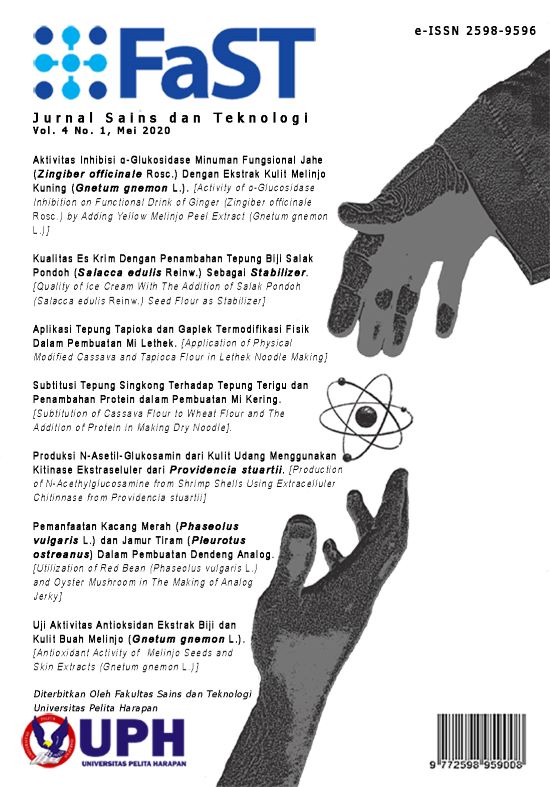SUBSTITUSI TEPUNG SINGKONG TERHADAP TEPUNG TERIGU DAN PENAMBAHAN PROTEIN DALAM PEMBUATAN MI KERING [SUBSTITUTION OF CASSAVA FLOUR TO WHEAT FLOUR AND THE ADDITION OF PROTEIN IN MAKING DRY NOODLE]
Keywords:
cassava flour, dry noodle, egg, isolate soy protein, subtitutionAbstract
Cassava flour is a local Indonesian food that has the potential to reduce the use of wheat flour in making noodles. However, cassava flour has sticky physical characteristics because the high amylopectin may be overcome by adding protein. The purpose of this study is to utilize cassava flour in the manufacture of dried noodles that have good physical characteristics. Another goal is to determine the level of substitution of cassava flour to wheat flour and the addition of a type of protein source and its concentration that can produce the best dry noodles. The research method used was an experimental method by making phase 1 treatments, namely protein type (control / without protein addition, ISP 5%, ISP 10%, egg 5%, egg 10%, egg 15%) in the manufacture of cassava flour substitute dry noodles, and stage 2 treatments namely the level of substitution of cassava flour (20, 30, 40%) and the best protein concentration of stage 1 plus or minus 2.5%). The results showed that the addition of eggs produced dry noodles with better physical and hedonic characteristics than control noodles or noodles with the addition of ISP. The best physical characteristics of noodles result from the addition of 15% eggs. In the Phase 2 experiment it was found that substitution of 20% cassava flour and the addition of 15% eggs produced noodles with the best physical and hedonic characteristics. The dried noodles meet SNI standards and contain 4.50% water, 1.94% ash, 13.7% protein, 2.46% fat, 168.66% water absorption, cooking loss 6.63%, springiness 0, 98 mm, adhesiveness 24.07 gs, and overall hedonic value of 5.25 ± 1.02 (hedonic scale 1-7).Cassava flour is a local Indonesian food that has the potential to reduce the use of wheat flour in making noodles. However, cassava flour has sticky physical characteristics because the high amylopectin may be overcome by adding protein. The purpose of this study is to utilize cassava flour in the manufacture of dried noodles that have good physical characteristics. Another goal is to determine the level of substitution of cassava flour to wheat flour and the addition of a type of protein source and its concentration that can produce the best dry noodles. The research method used was an experimental method by making phase 1 treatments, namely protein type (control / without protein addition, ISP 5%, ISP 10%, egg 5%, egg 10%, egg 15%) in the manufacture of cassava flour substitute dry noodles, and stage 2 treatments namely the level of substitution of cassava flour (20, 30, 40%) and the best protein concentration of stage 1 plus or minus 2.5%). The results showed that the addition of eggs produced dry noodles with better physical and hedonic characteristics than control noodles or noodles with the addition of ISP. The best physical characteristics of noodles result from the addition of 15% eggs. In the Phase 2 experiment it was found that substitution of 20% cassava flour and the addition of 15% eggs produced noodles with the best physical and hedonic characteristics. The dried noodles meet SNI standards and contain 4.50% water, 1.94% ash, 13.7% protein, 2.46% fat, 168.66% water absorption, cooking loss 6.63%, springiness 0, 98 mm, adhesiveness 24.07 gs, and overall hedonic value of 5.25 ± 1.02 (hedonic scale 1-7).References
Anni, F. 2008. Patiseri. Jakarta: Direktorat Pembinaan Sekolah Menengah Kejuruan. AOAC. 2005. Official Methods of analysis. Washington: Association of Official Analytical Chemist. Alam, N., M.S. Saleh, dan S.U. Haryadi. 2007. Sifat fisikokimia dan sensoris instant strach noodle pati Aren pada berbagai cara pembuatan. Journal Agroland 14(4): 269-274. Andri, I. 2003. Mempelajari pengaruh penambahan isolat protein kedelai sebagai bahan Ppngikat terhadap mutu fisik dan organoleptik meat loaf. Bogor : Fakultas Teknologi Pertanian. Institut Pertanian Bogor. Skripsi. Ario, J. Julianti, E. dan Yusriani, E. 2015. Karakteristik egg replacer dari isolat protein kedelai, isolat protein susu, pati jagung, pati kentang, guar gum dan xanthan gum. Jurnal Rekayasa Pangan dan Pertanian. 3(4) : 424-433. Astawan, M. 1991.Teknologi Pengolahan Pangan Nabati. Jakarta : Akademika Presindo. Astawan, I. M. 2002. Membuat Mi dan Bihun. Jakarta: Penebar Swadaya. Astuti, R.T., Darmanto, Y.S., dan Wijayanti, I. 2014. Pengaruh penambahan isolat protein kedelai terhadap karakteristik bakso dari surimi ikan Swangi. Jurnal Pengolahan dan Bioteknologi Hasil Perikanan 3(3): 47-54. Biro Humas Kementan. Data Kementrian Selaras dengan Data BPS. 2017. Tersedia pada : http://www.pertanian. go.id/ap_posts/detil/1181/2017/09/28/09/30/05/Data%20Kementan%20Selaras%20Dengan%20Data%20BPS. Diakses pada: 10 Juli 2019. Biyumna, U., Windrati, Wiwik., Diniyah, N. 2017. Karakteristik mi kering substitusi tepung singkong terbuat dari tepung Sukun (Artocarpus altilis) dan penambahan telur. Jurnal Argoteknologi 11(1): 23-34. Budiyati, C. S., dan Kumoro, A. C. 2012. Teknologi Pembuatan dan Karakterisasi Mie Kaya Protein dari Tepung Gadung. Semarang: UNDIP. Cham, S., dan Suwannaporn, P. 2010. Effect of hydrothermal treatment of rice flour on various rice noodles quality. Journal of Cereal Science. 2(1): 284-291 Chen, Z., H.A. Schols, and A.G.J.Vorgaren. 2003. Starch granule size strongly determines starch noodle processing and noodle quality. Journal of Food Science. 68(5): 1584-1589. Ekthamasut, K. 2006. Effect of tomato seed meal on wheat properties and alkaline noodle qualities. Australian Journal Technology 9 (3): 147-152. Eliason, A.C. and M. Gudmundsson. 2012. Starch: Physicochemical and Functional Aspect. Dalam : Eliason, A,C. Carbohydrate in Food. New York: Marcel Dekker. Faridah, A. dan Widjanarko, S. B. 2014. Penambahan tepung Porang pada pembuatan mi dengan substitusi tepung MOCAF. Jurnal Teknologi Pangan. 25(1): 98-105. Imaningsih, N. 2012. Profil Gelatinasi Beberapa Formulasi Tepung-tepungan untuk Pendugaan Sifat Pemasakan. Jurnal Panel Gizi Makan. 35(1): 13-12. Indrianti, N., R. Kumalasari,R. Ekafitri, dan Darmajana. D. A. 2013. Pengaruh Penggunaan Pati Ganyong, Tapioka, dan Mocaf sebagai Bahan Substitusiterhadap Sifat Fisik Mie Jagung Instan.Agritech 33(4): 1-8 Indrianti, N., Sholichah, E. dan Darmajana, D.A. 2014. Proses Pembuatan Mi Jagung Dengan Bahan Baku Tepung Jagung 60 Mesh Dan Teknik Sheeting-slitting. Pangan 2(3): 256-266. Inglett, G. E., S. C. Peterson, C. J. Carriere, dan Maneepun. 2015. Rheological, Textural, and Sensory Properties of Asian Noodles Containing An Oat Cereal Hydrocolloid. Food Chemistry 90(1): 1-8 Kong, X., Bao, J. dan Corke H. 2009. Physical properties of Amaranthus starch. Food Chemistry 113: 371-376. Koswara, S. 2013. Teknik Pengolahan Umbi-Umbian : Pengolahan Umbi Talas. Modul.IPB. Bogor. Kovacs, M.I.P., Fu, B.X., Woods, S.M ., and Khan, K. 2004. Thermal stability of wheat gluten protein: Its effect on dough properties and noodle texture. Journal of Cereal Science 39(1):9-19. Kusnandar, F. 2010. Kimia Pangan Komponen Pangan. Jakarta: PT. Dian Rakyat. Lawless, H, and Heymann, H. 2010. Sensory Evaluation of Food Principles and Practices Second Edition. New York : Springer. Muhandri T., Ahza A. B., Syarief, R., dan Sutrisno. 2011. Optimasi proses ekstrusi mi jagung dengan metode respon permukaan. J Teknol dan Industri Pangan 22: 97-104 Mulyadi, A., Wijana, S., Dewi, I. A., dan Putri , W. 2014. Karakteristik organoleptik produk mi kering substitusi tepung singkong ubi jalar kuning (Ipomoea batatas) dengan penambahan telur dan CMC. Jurnal Teknologi Pertanian. 1186-1194. Nurcahyo, E. Amanto, B.S., dan Nurhatadi. 2014. Kajian penggunaan tepung sukun sebagai substitusi tepung terigu pada pembuatan mi kering substitusi tepung singkong. Jurnal Teknosains Pangan 3(2): 57-65. Rahayu, I. 2003. Karakteristik fisik, komposisi kimia dan uji organoleptik ayam Merawang dengan pemberian pakan bersuplemen omega-3. Jurnal Teknologi dan Industri Pangan XIV (3): 199-205. Risti, Y. 2013. Pengaruh penambahan telur terhadap kadar protein, serat, tingkat kekenyalan dan penerimaan mi basah bebas gluten berbahan baku tepung komposit. Semarang : Program Studi S1 Ilmu Gizi . Fakultas Kedokteran. Universitas Diponegoro. Skripsi. Rustandi, D. 2011. Produksi Mie. Solo : Tiga Serangkai. Rosida, R. 2013. Mi dari Tepung Komposit dan Penambahan Telur. Jurusan Teknologi Pangan: FT UPN Veteran Sadjad, S. 2000. Bahan Pangan Sumber Karbohidrat. Penebar Swadaya. Jakarta. Safriani, N. Ryan, M. dan Ferizal. 2013.Pemanfaatan Pasta Sukun Pada Pembuatan Mi kering substitusi tepung singkong. Jurnal Teknologi dan Industri Pertanian Indonesia. 5(2):17-24. Satin. 2001. Functional Properties of Starches. AGSI Homepage.http://www.FAO.org. Setyani, S. Astuti, S. dan Florentina. 2017. Substitusi Tepung Tempe Jagung dalam Pembuatan Mi Basah. Jurnal Teknologi dan Hasil Industri Pertanian. 22 (1): 1-10. SNI. 2015. Standar Mi Kering. Badan Standarisasi Nasional Indonesia. Jakarta Subarna, Muhandri T, Nurtama B, Fierliyanti AS. 2012 Peningkatan mutu mi kering substitusi tepung singkong jagung dengan penerapan kondisi optimum proses dan penambahan monogliserida. J Teknol dan Industri Pangan. 23(2): 146-152. Utama, A.N. 2016. Substitusi Isolat Protein Kedelai pada Daging Analog Kacang Merah. Universitas Diponegoro Fakultas Kedokteran. Semarang Utomo, R. 2016. Evaluasi Penmabahan Propilen Glikol Alginat (PGA) dan Isolated Soy Protein (ISP) sebagai Rheological Modifier terhadap Parameter Fisik Mi Jagung. Institut Pertanian Bogor: Bogor. Wasono, M, S dan Yuwono, S. 2014. Pendugaan umur simpan tepung pisang goreng menggunakan metode accelerated shelf life testing dengan pendekatan Arrhenius. Jurnal Pangan dan Agroindustri 2 (4): 178-187. Winarti, S., Susiloningsih, E. K dan Fasroh, F. Y. 2017. Karakteristik Mi kering dengan substitusi tepung Gembili dan penambahan plastiziser GMS (Gliserol Mono Stearat). AGROINTEK 11(2) : 53-62. Witono, J. R., Kumalaputri, A. J dan Lukman, H. S. 2012. Optimasi rasio tepung terigu, tepung pisang, dan tepung ubi jalar, serta konsentrasi zat aditif pada pembuatan mie. Lembaga Penelitian dan Pengabdian Kepada Masyarakat Universitas Katolik Parahyangan. Laporan Penelitian. Zayas, J.F. 1997. Functionality of Protein Food. Berlin : Springer Verlag.
Downloads
Published
Issue
Section
License
“Authors who publish with this journal agree to the following terms:
1) Authors retain copyright and grant the journal right of first publication with the work simultaneously licensed under a Creative Commons Attribution License (CC-BY-SA 4.0) that allows others to share the work with an acknowledgement of the work's authorship and initial publication in this journal.
2) Authors are able to enter into separate, additional contractual arrangements for the non-exclusive distribution of the journal's published version of the work (e.g., post it to an institutional repository or publish it in a book), with an acknowledgement of its initial publication in this journal.
3) Authors are permitted and encouraged to post their work online (e.g., in institutional repositories or on their website). The final published PDF should be used and bibliographic details that credit the publication in this journal should be included.”



